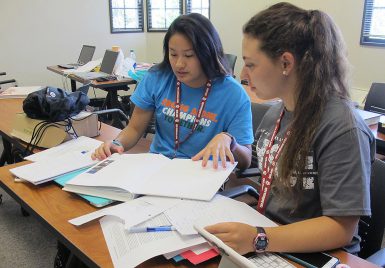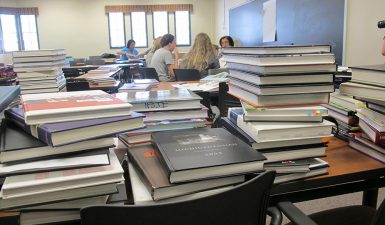High School Journalism Institute wraps 70th year

The Media School’s High School Journalism Institute just wrapped its 70th year, with more than 300 students from around the country attending workshops to learn reporting, photography, design, broadcast and public relations skills.
The key to longevity – and to appeal to high school students – is the focus on adapting to the changing media environment, says director and Media School senior lecturer Teresa White. She draws on her years as a high school journalism teacher and advisor, and her own HSJI experience, to guide her curriculum decisions.
“When I attended HSJI in 1979, we typed on manual typewriters,” she said as a comparison to this summer’s toolkit, which included Adobe Spark for the first time. “Everything seemed to be very paper-based. Everything was only about reporting and editing and managing.”
Those skills still are the foundation, but the institute also offers almost 20 different classes covering a wide range of topics including web packaging, photography, television news, documentary film, yearbook and multimedia.
First-time HSJI student Kathryn Stamm and her fellow staffers from Signature School in Evansville appreciated the variety of courses available.
“We’re the photographers, writers and designers,” Stamm said. “We do it all.”
Student Maria Thames from Libertyville High School worked on the institute’s public relations team, covering the events of HSJI as the week progresses. She said she enjoyed working with other students to create multimedia coverage.

“We all have a different job, and since they’re all so different, we can take our different skills and put them together to make something new,” Thames said.
Students in the converged newsroom workshop work as team to “do it all.” They take on different roles, such as reporters, videographers and designers, to produce an online magazine. They start in a reporting boot camp, then break off to follow newsmakers on campus and create media packages.
The converged newsrooms, introduced two years ago, featured sections on arts reporting and on sports reporting this year. New this year was a documentary filmmaking session.
“There’s more at stake, and it’s more serious now,” White said of the need to continually update the curriculum. “What they’re doing today is more serious because of the implications of anyone being able to publish or broadcast.”
Students need training not only in tools needed to produce their work, but also in ethics, copyright and project development, she said. HSJI offers traditional workshops in news reporting and editing, photojournalism and broadcast news along with leadership, multimedia and web design, among others.
High school students also experience college life, living in dorms, dining in food courts and around campus, and gathering in classrooms where their older counterparts spend fall and spring semesters. They also have access to the tech equipment, labs and multimedia staff personnel at the school, same as Media School students.
They learn from seasoned pros, too. The workshops are taught by journalism teachers and advisors, as well as a few media professionals. Many return year after year, and they have to keep up with technology and other changes as well.
“Originally we were shooting film,” said photography instructor Meredith Bledsoe of her early years as an HSJI instructor. “We were developing here and scanning negatives. I’ve seen the full change from darkroom to digital and it’s been amazing.”
For Bledsoe, the most rewarding aspect of teaching is seeing her students progress with new technology and programs.
“I love seeing the confidence building and what the kids can take back to their staffs and pass on to their fellow staff members,” Bledsoe said. “I love those ‘aha’ moments, when kids figure out technology and aren’t afraid of programs like Photoshop.”

Instructors are utilizing programs like Adobe Creative Suite and WordPress to help students understand the role of technology in the newsroom. This year, they used Adobe Spark to enable students to create web-ready videos in record time.
“I want them to know that they’re learning and using is the same as what someone from Sports Illustrated or The New York Times is using,” Bledsoe said. “They’re producing on the same equipment and the same programs.”
Bledsoe said she hopes this gives her students “confidence that they can leave here and know they can take that knowledge back to their staff, and empowerment where they can be excited about journalism and value what they’re doing.”
In addition to the rewarding nature of helping students grow, instructors said they enjoy working with their longtime friends and colleagues. Many, like White, are former HSJI students themselves.
“It’s kind of like a reunion every year when people come back,” White said. “They have great camaraderie with each other, and they get to geek out over journalism.”

The last day of the institute features an award ceremony, where students are recognized for their work. Family members attend, and many reminisce on their times at HSJI. White said she knows families where grandparents, parents and current students all are HSJI alumni.
For instructor Jeff Gabbard, his time as a Hoosier and his passion for the institute keep him coming back.
“For me, coming back to IU is like coming home,” said Gabbard, journalism advisor at Richmond High School who received his IU journalism degree in 1986. “I went to school here, I graduated from here and I took classes here. It’s a rejuvenating experience to come back here, and I’ll keep coming back until I can’t sleep on dorm beds anymore.”
Additional reporting by Taylor Haggerty.
Podcast:
https://soundcloud.com/iu-media-school/high-school-journalism-institute-2016

